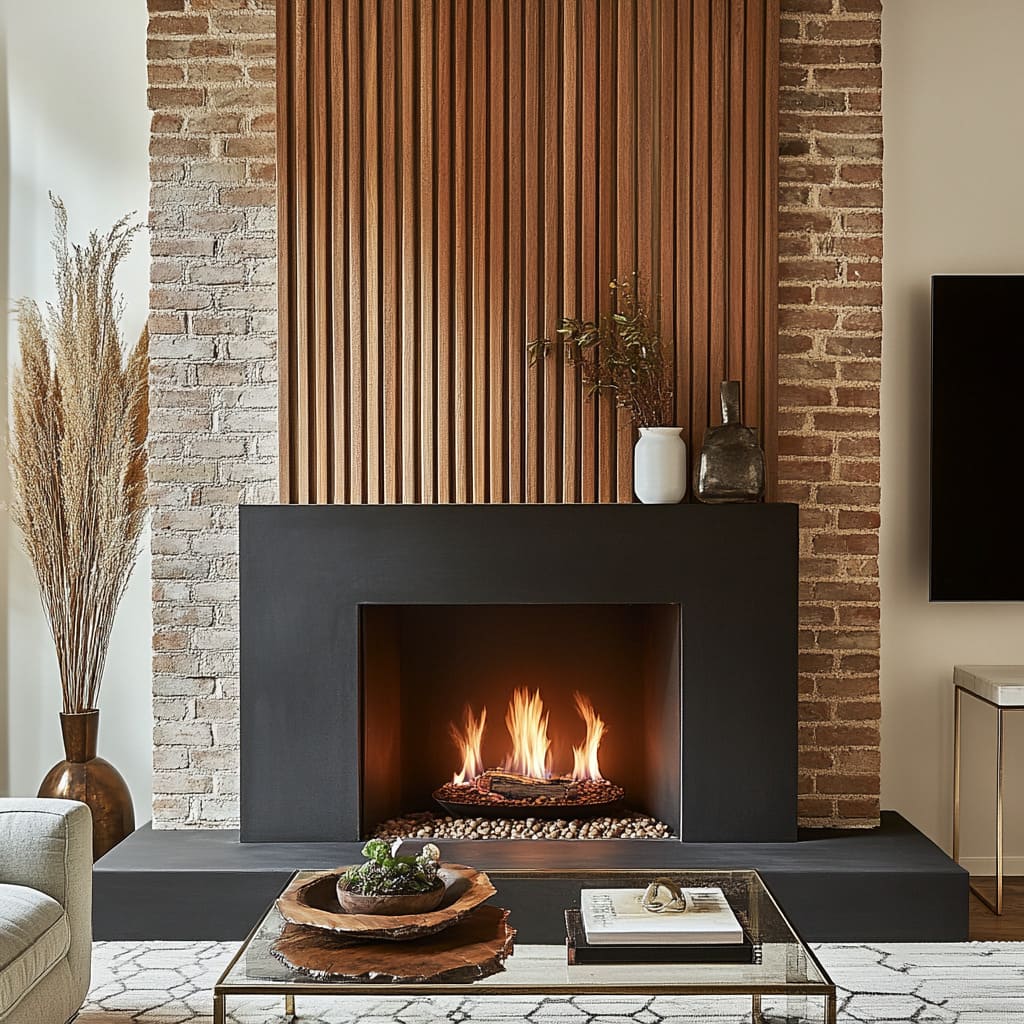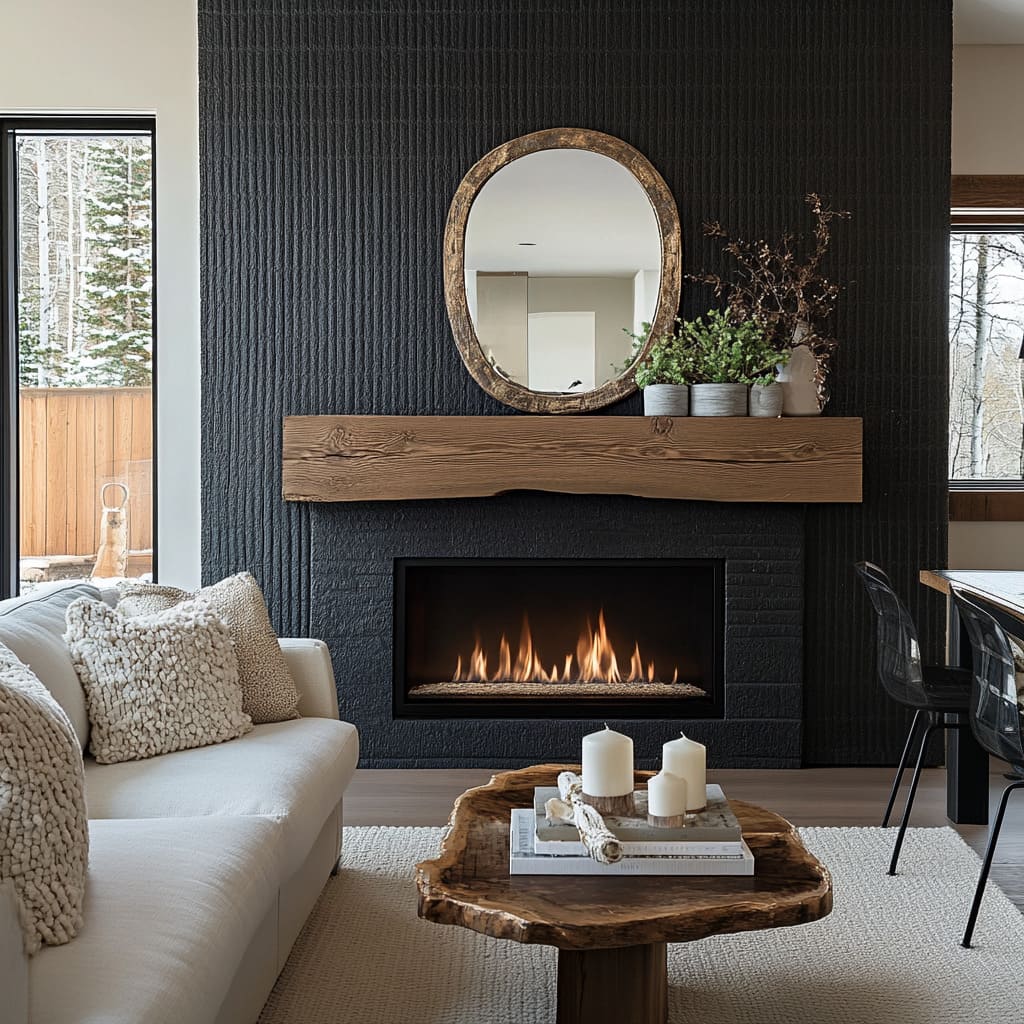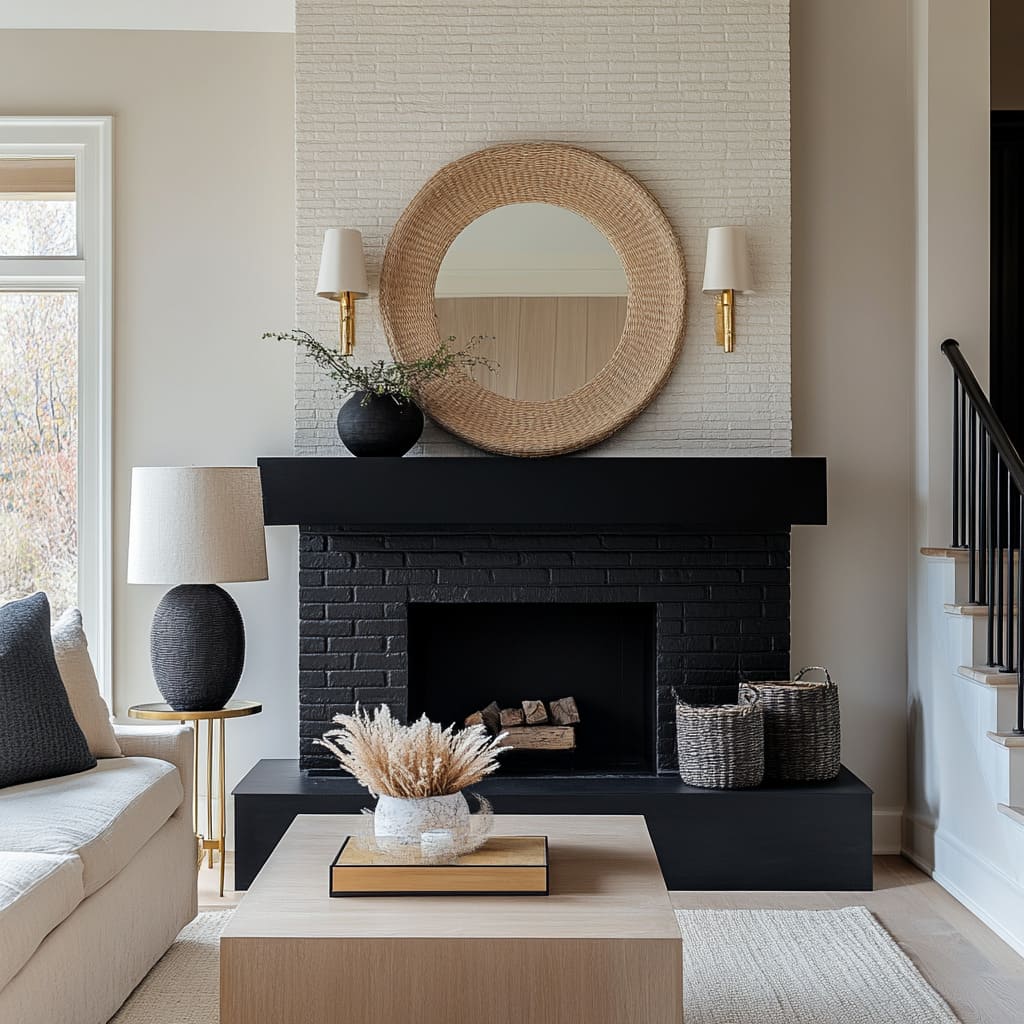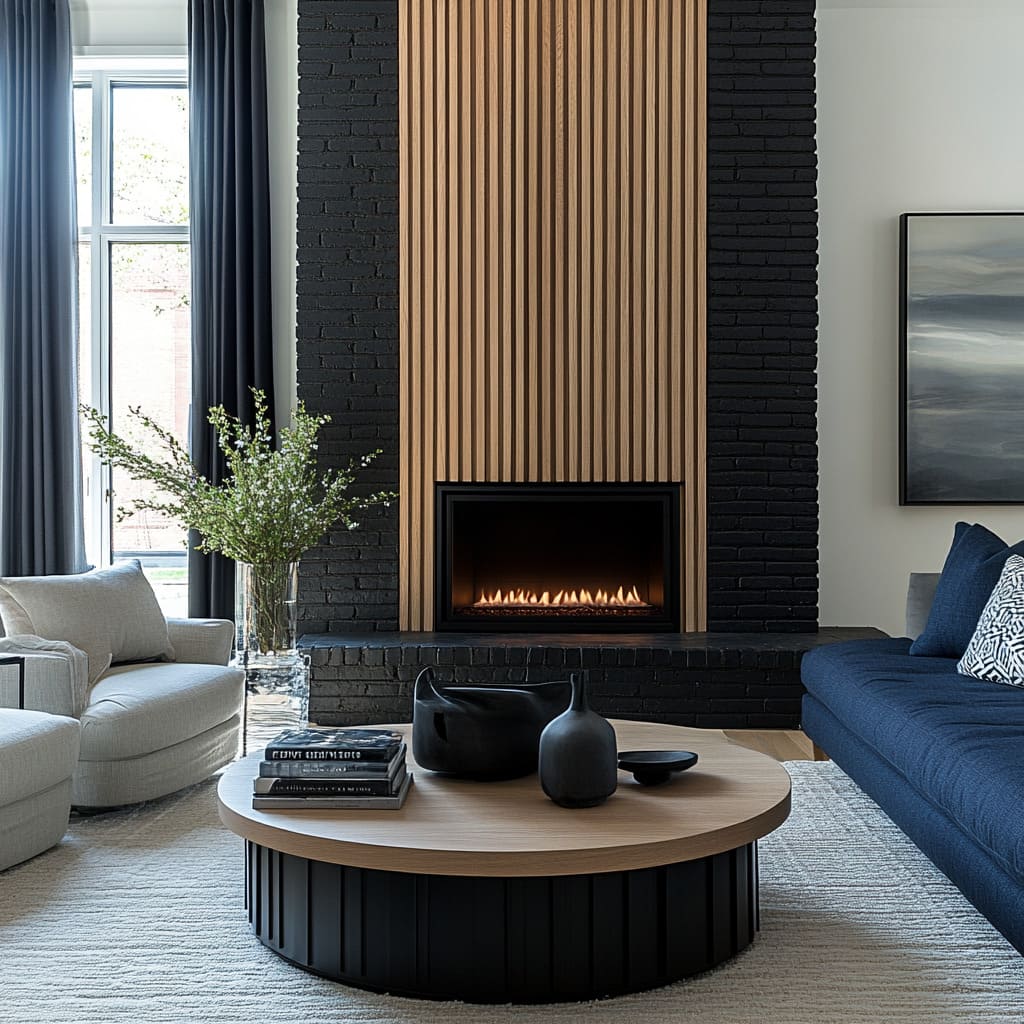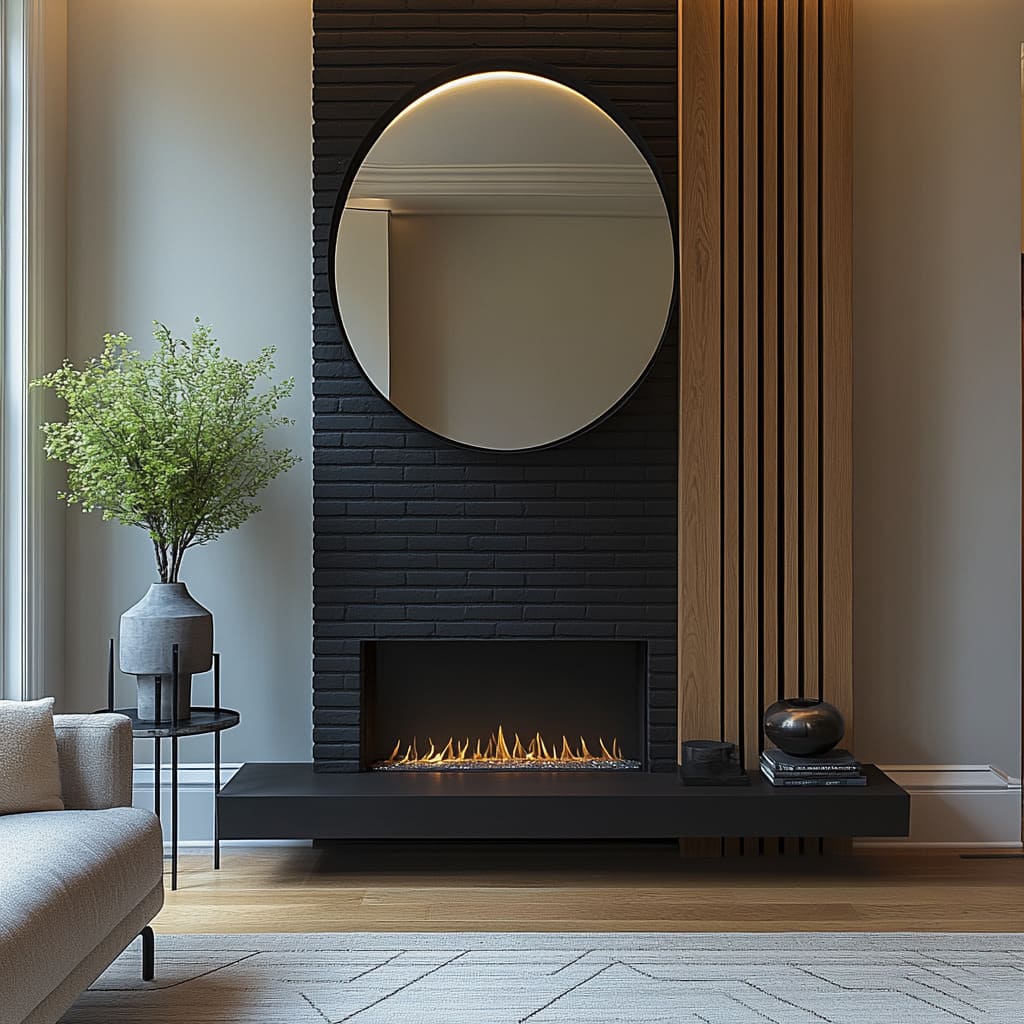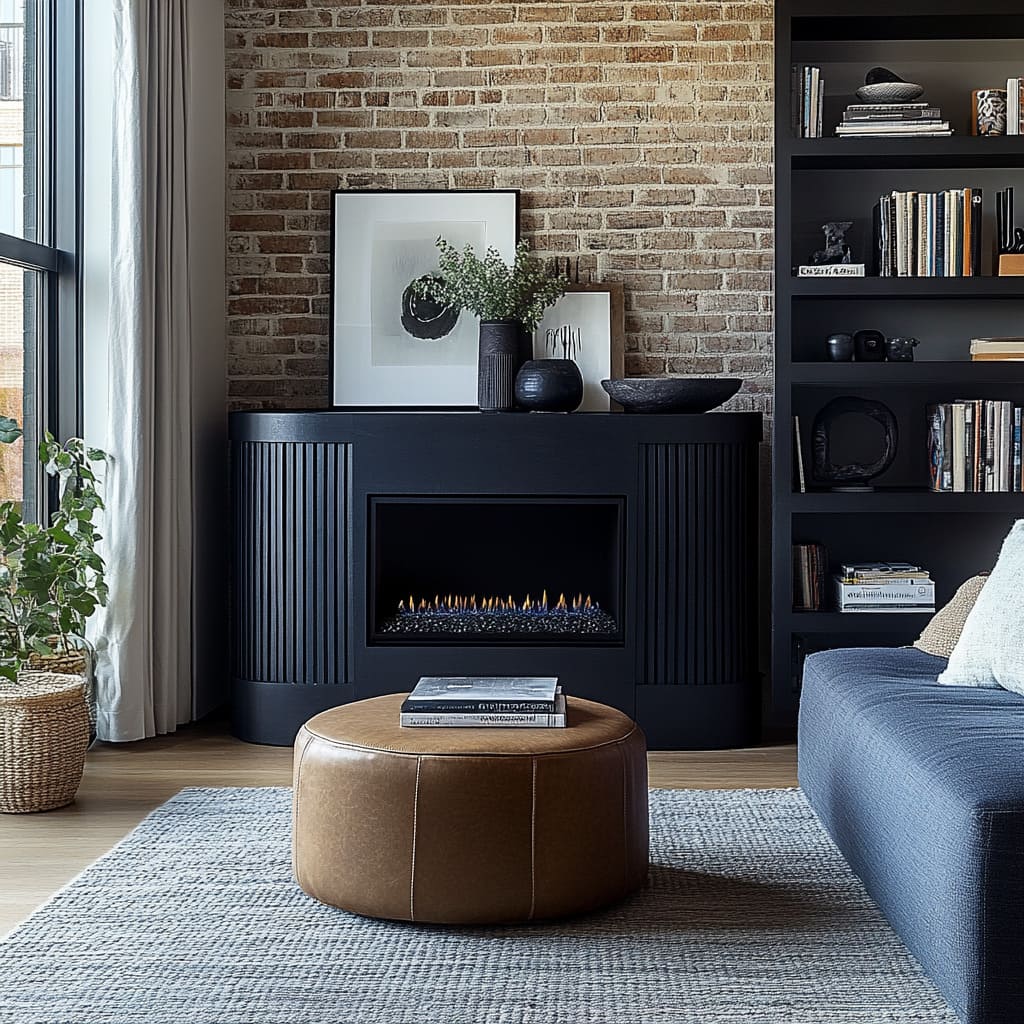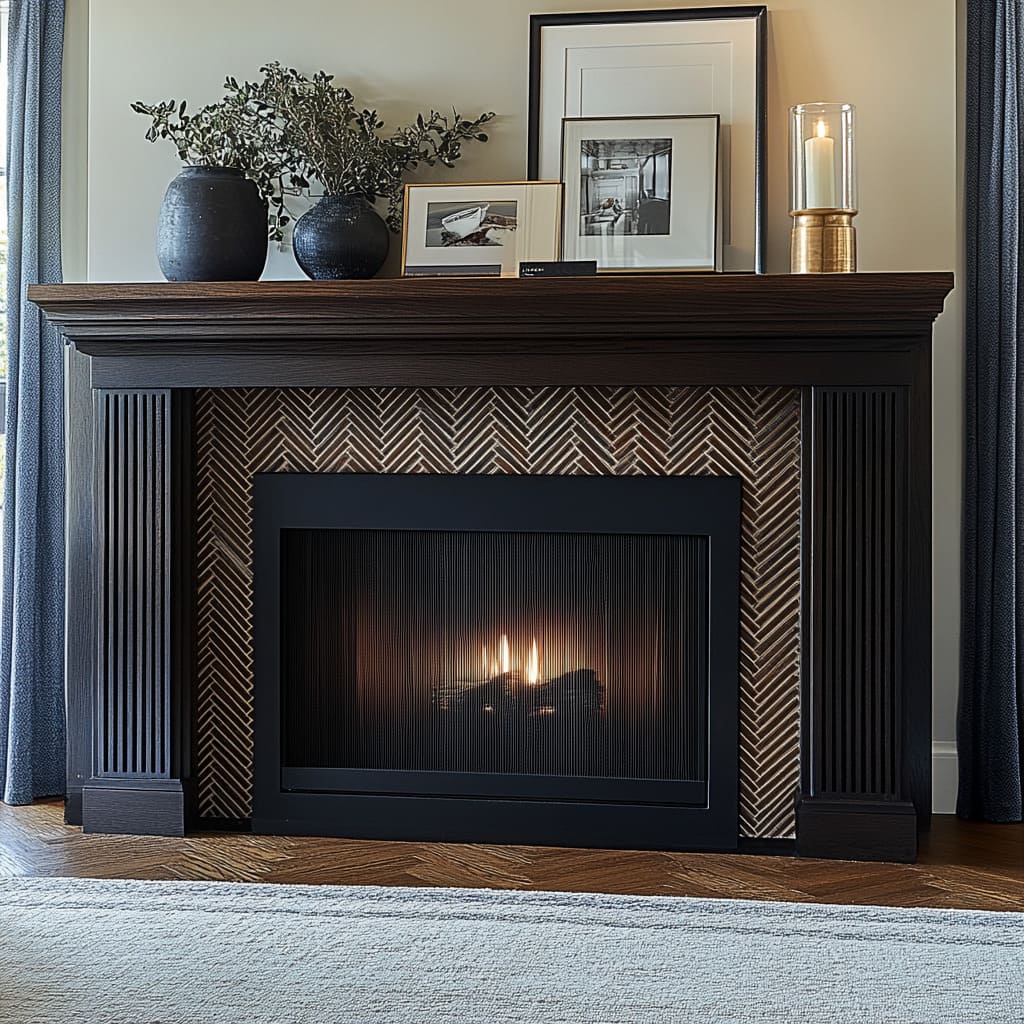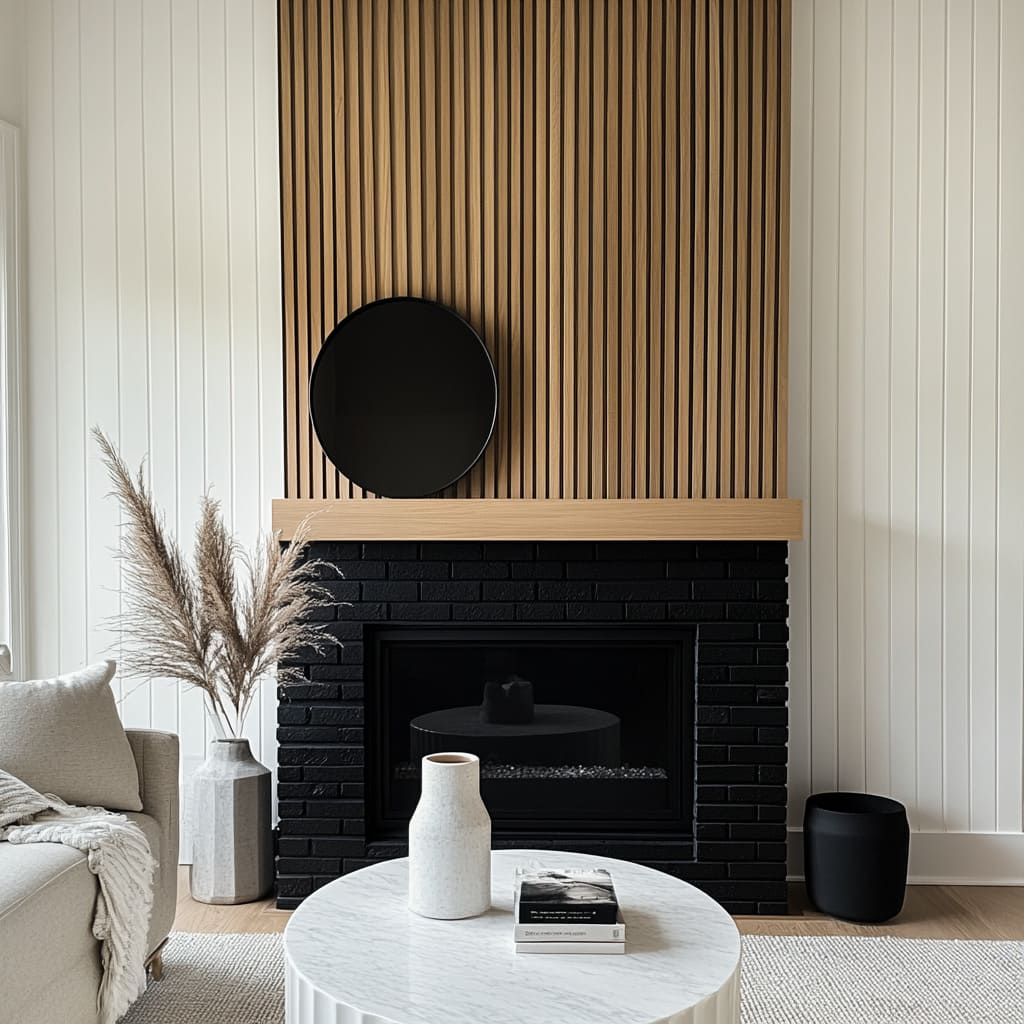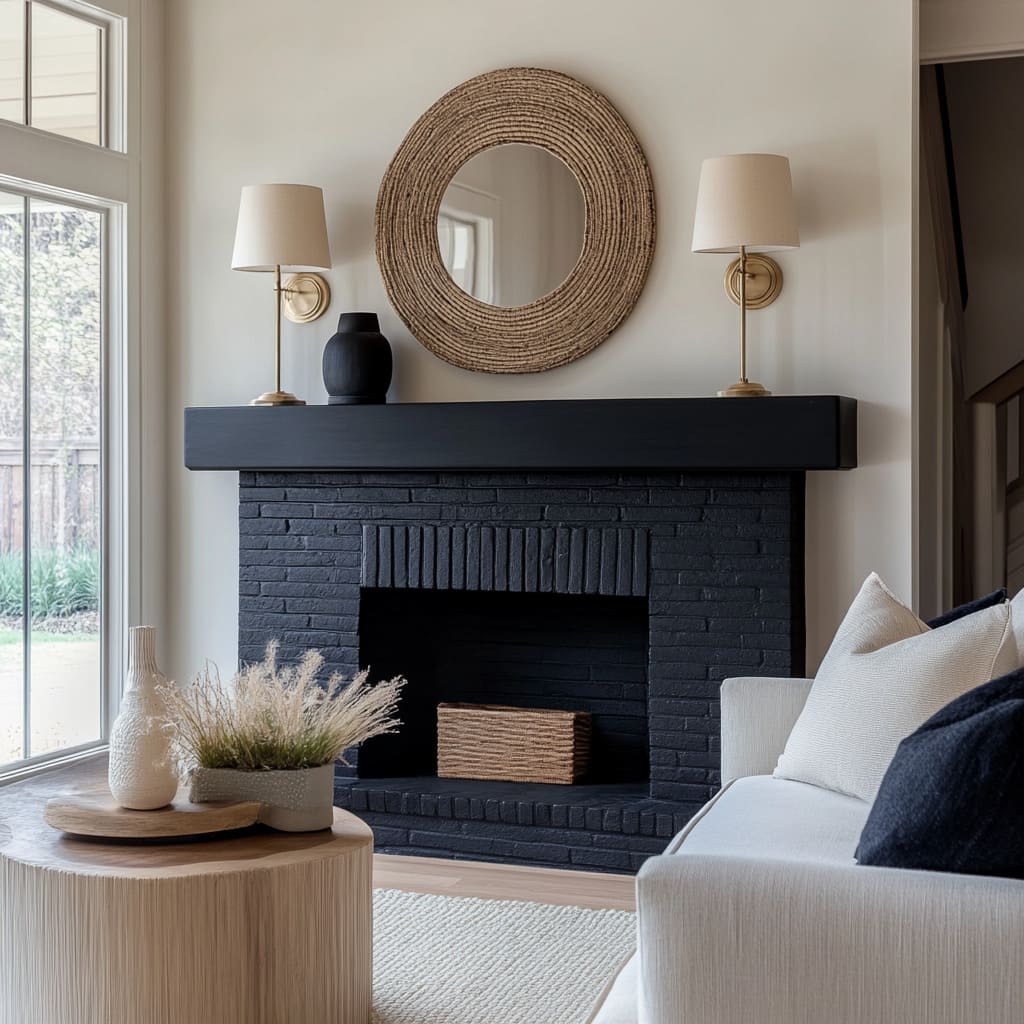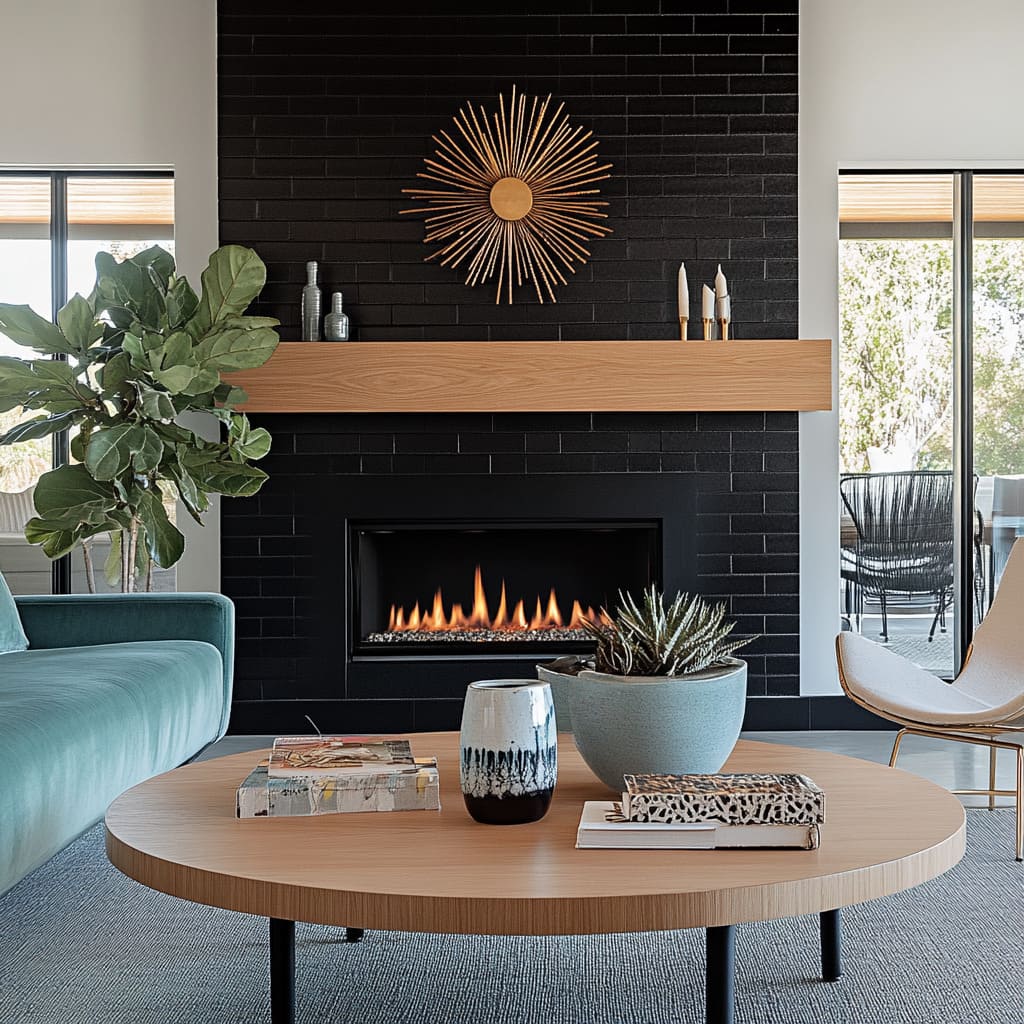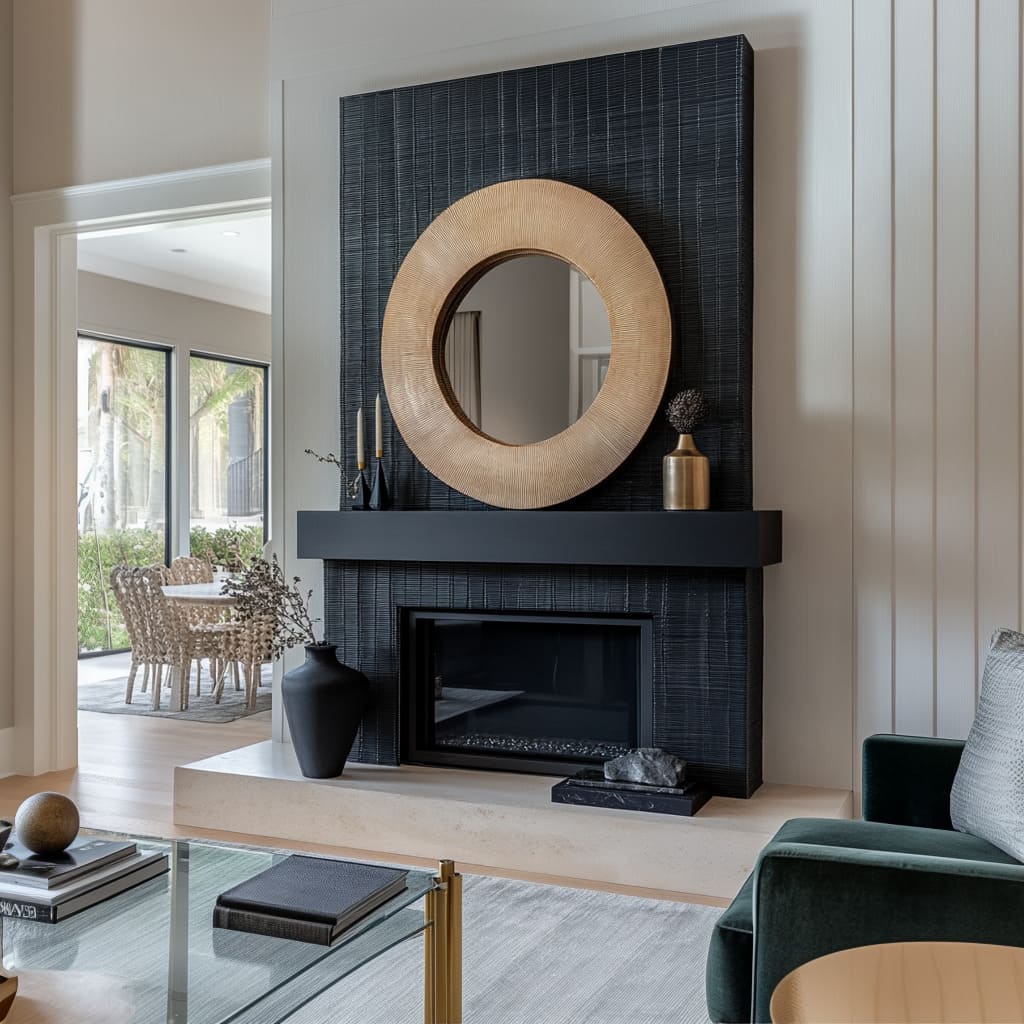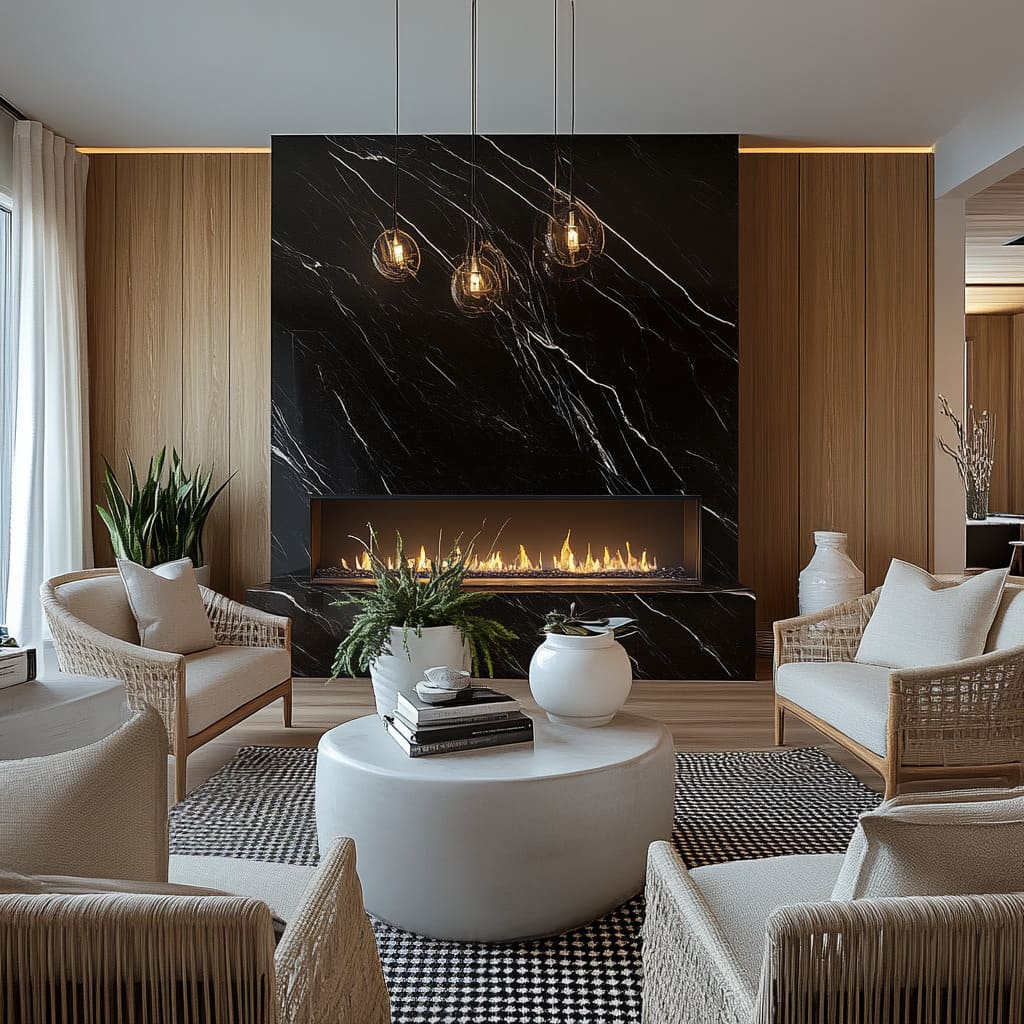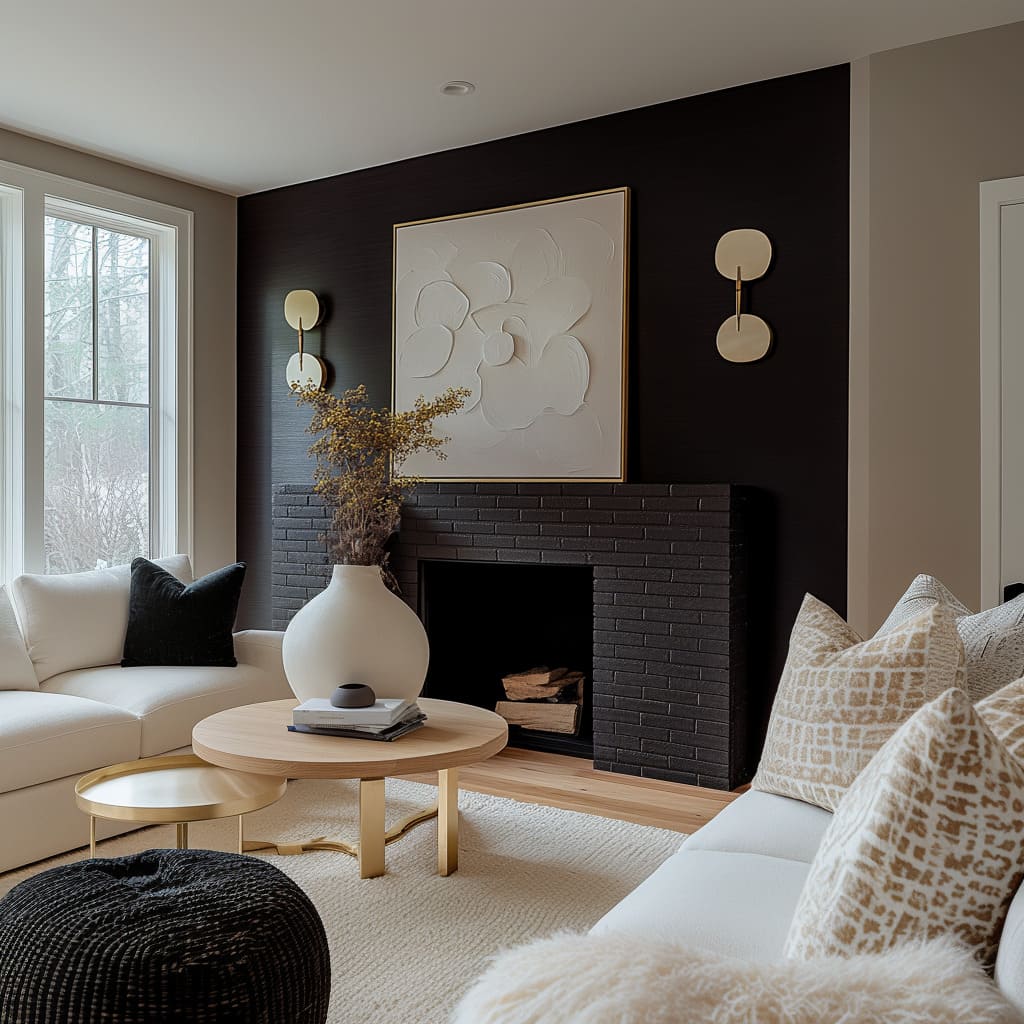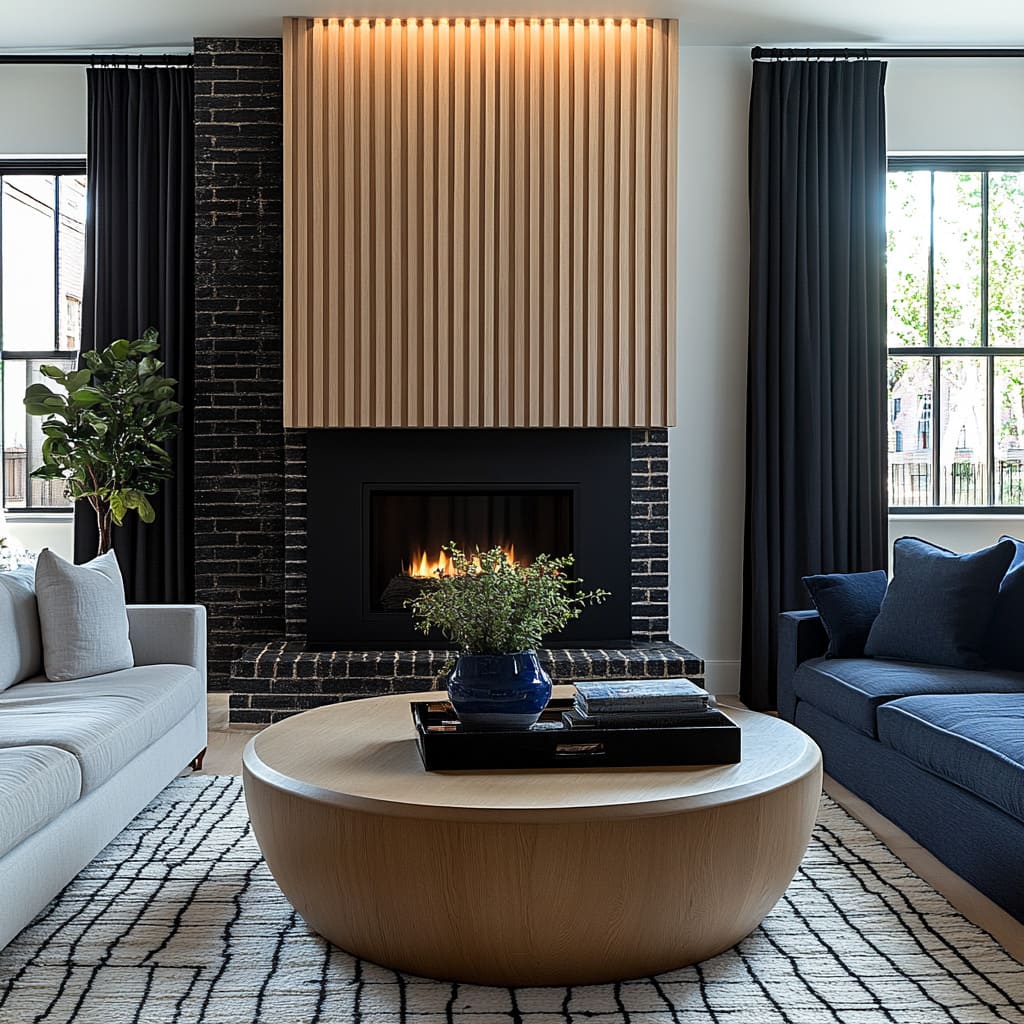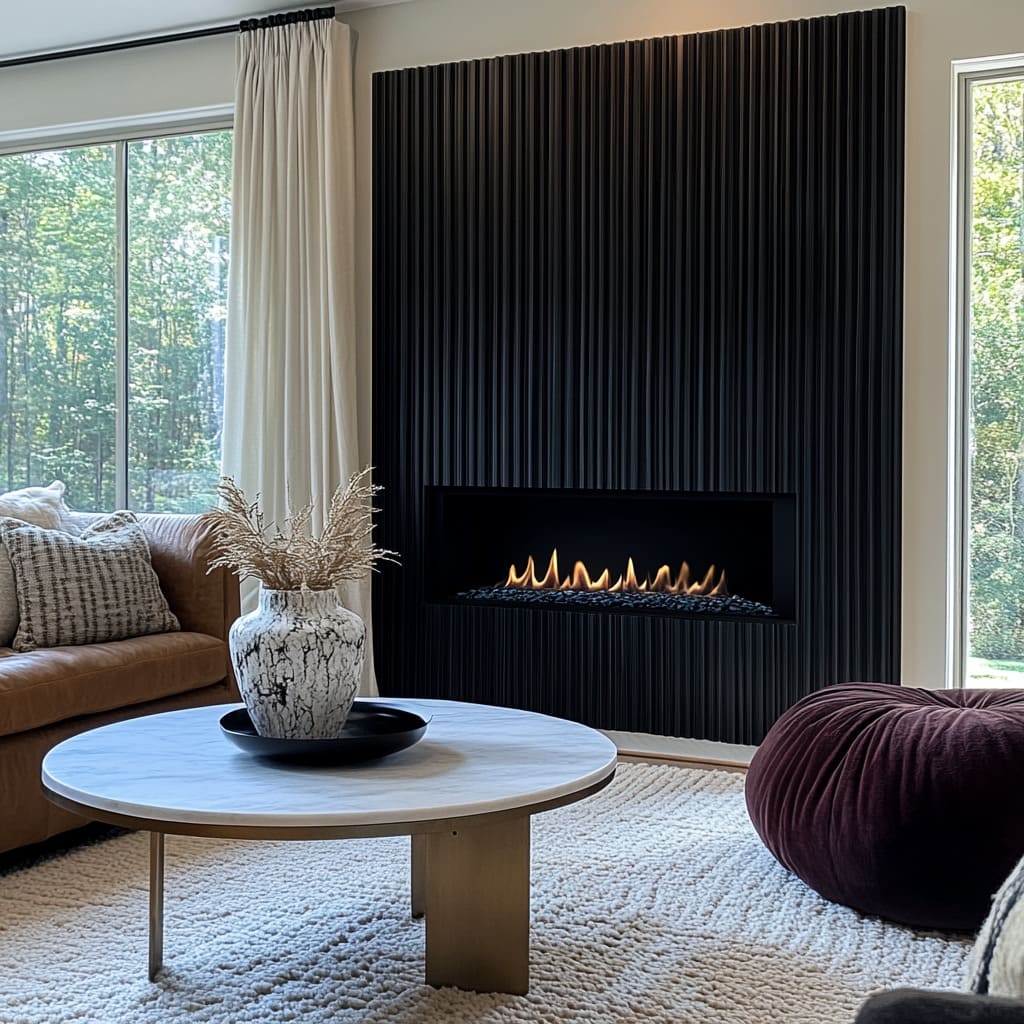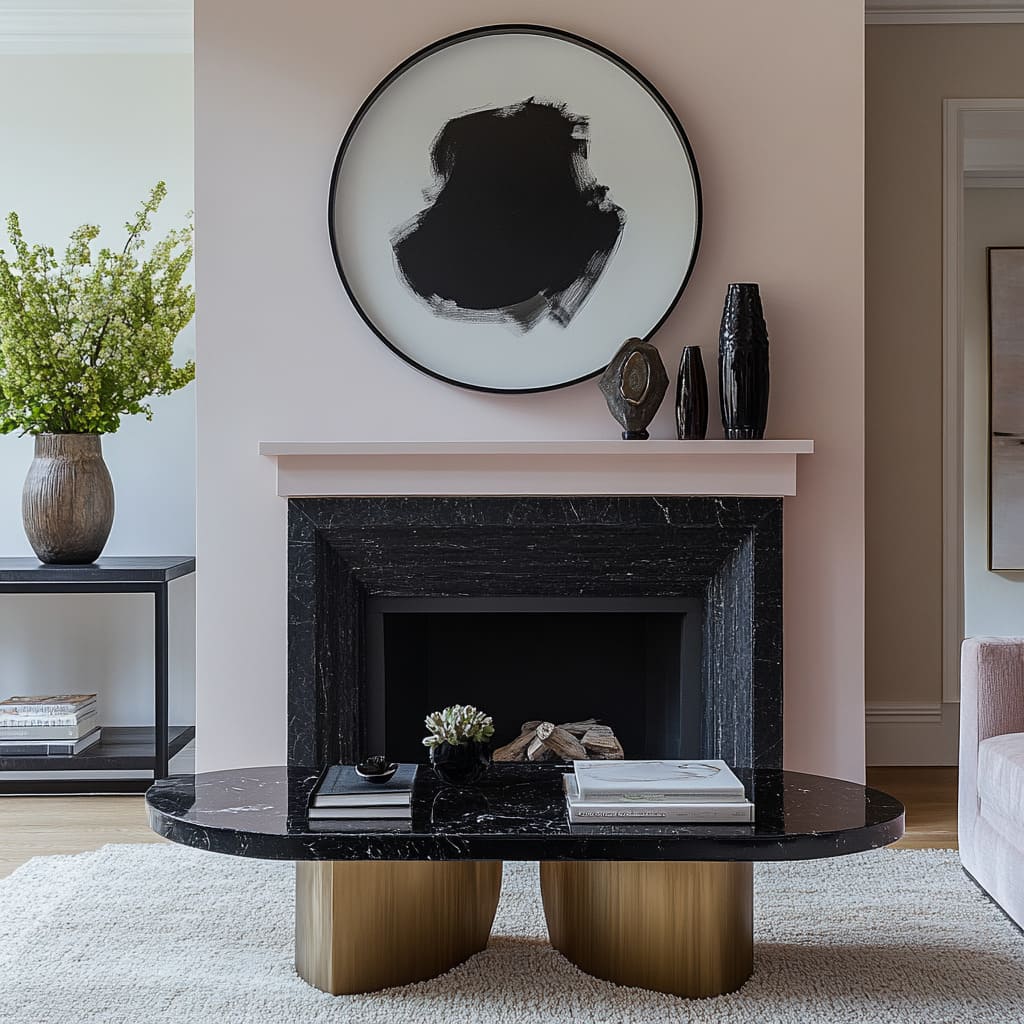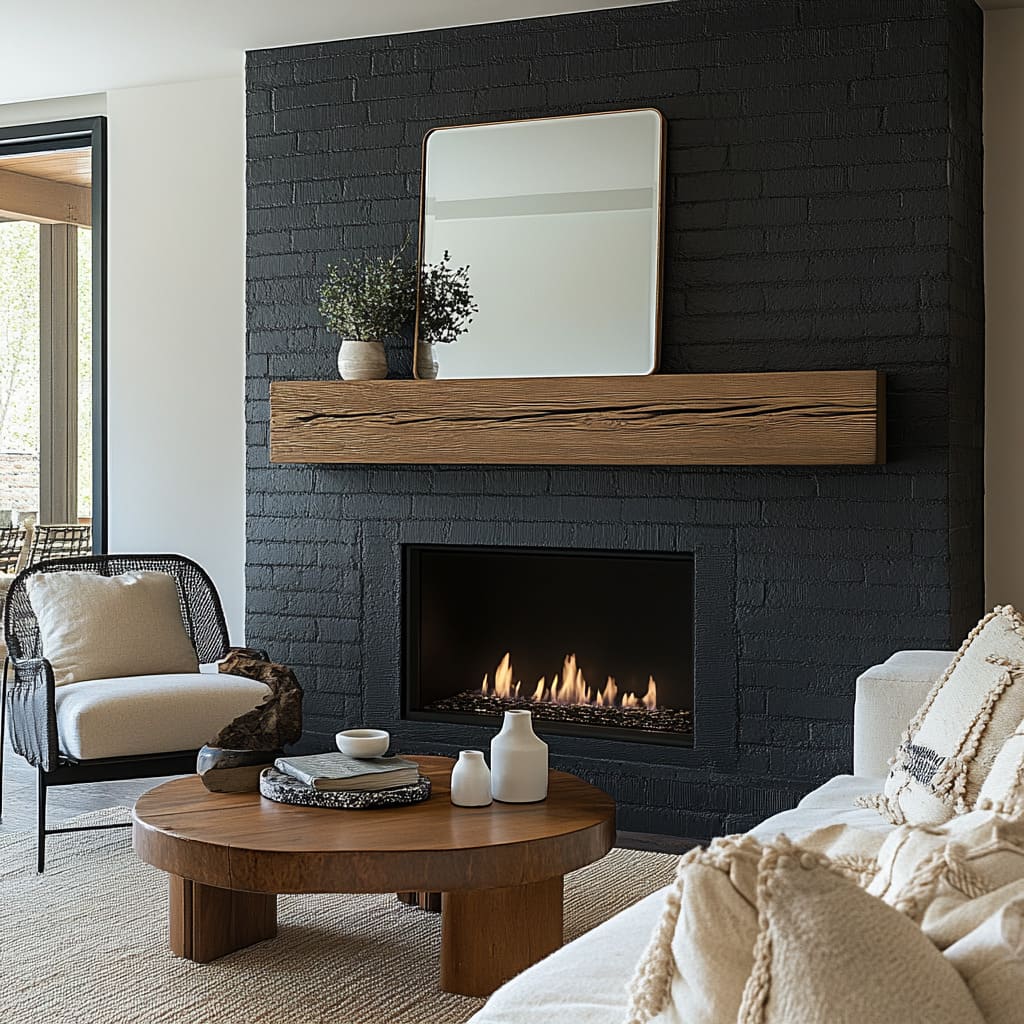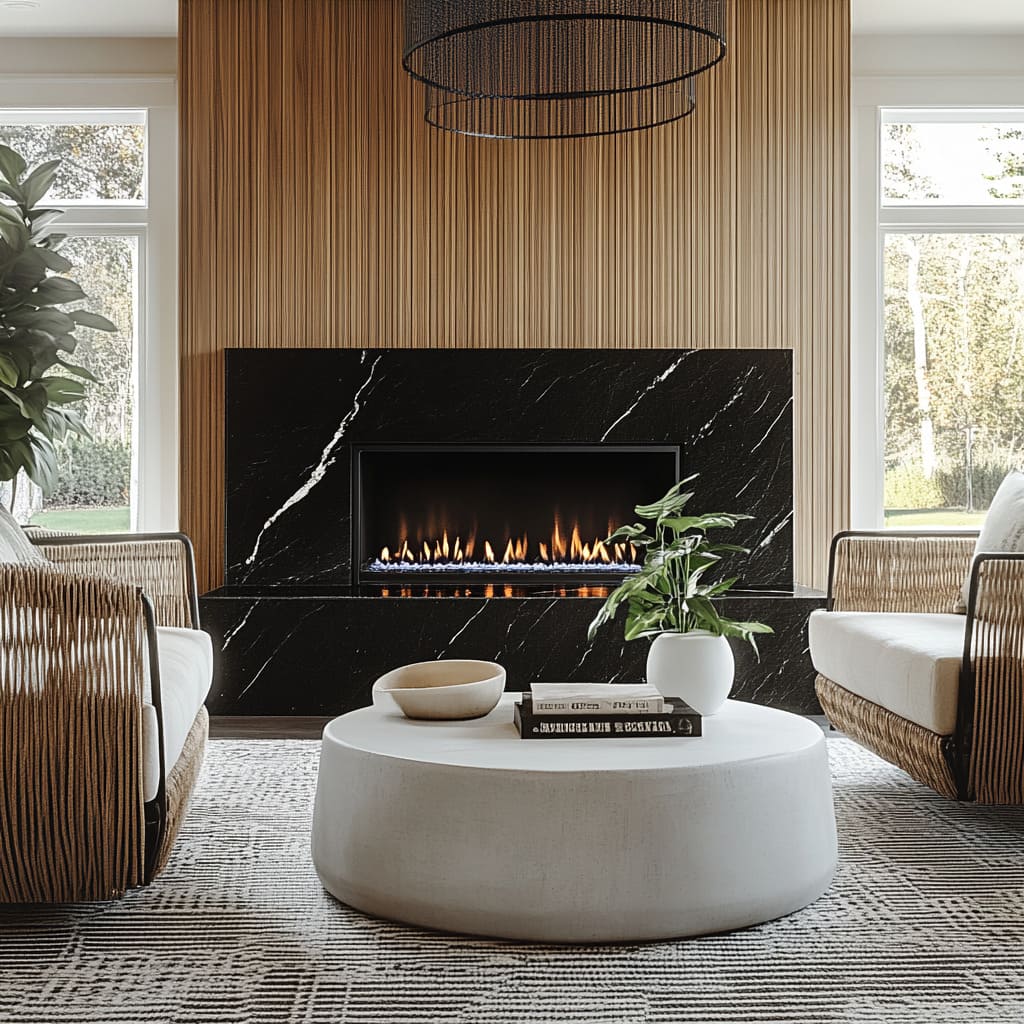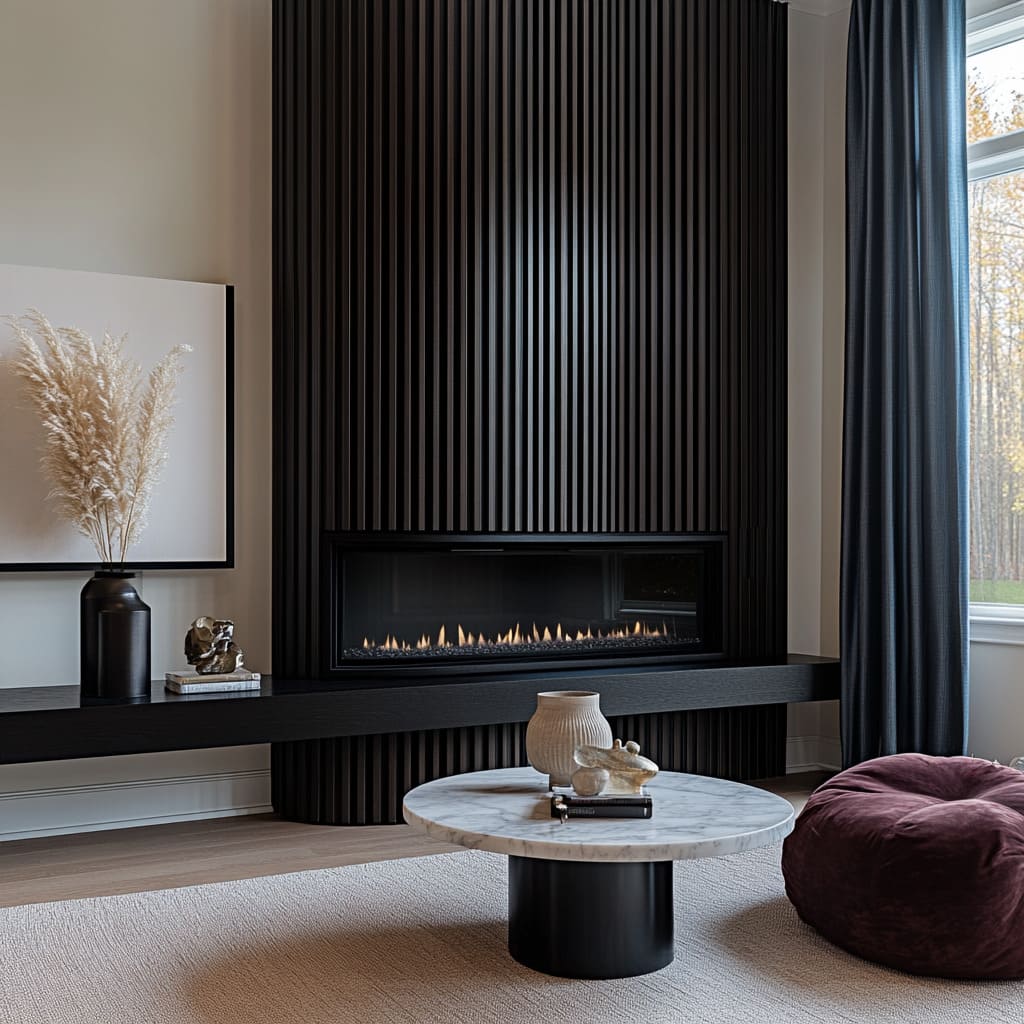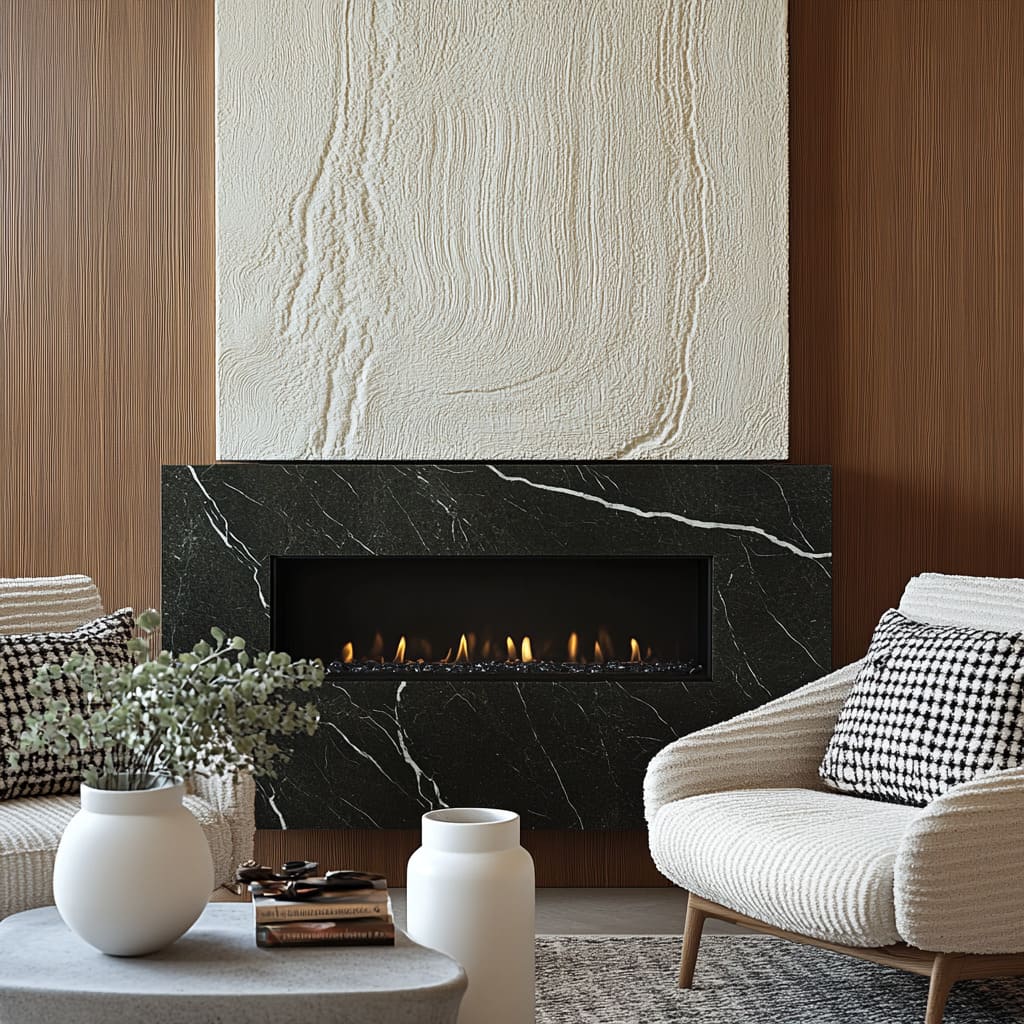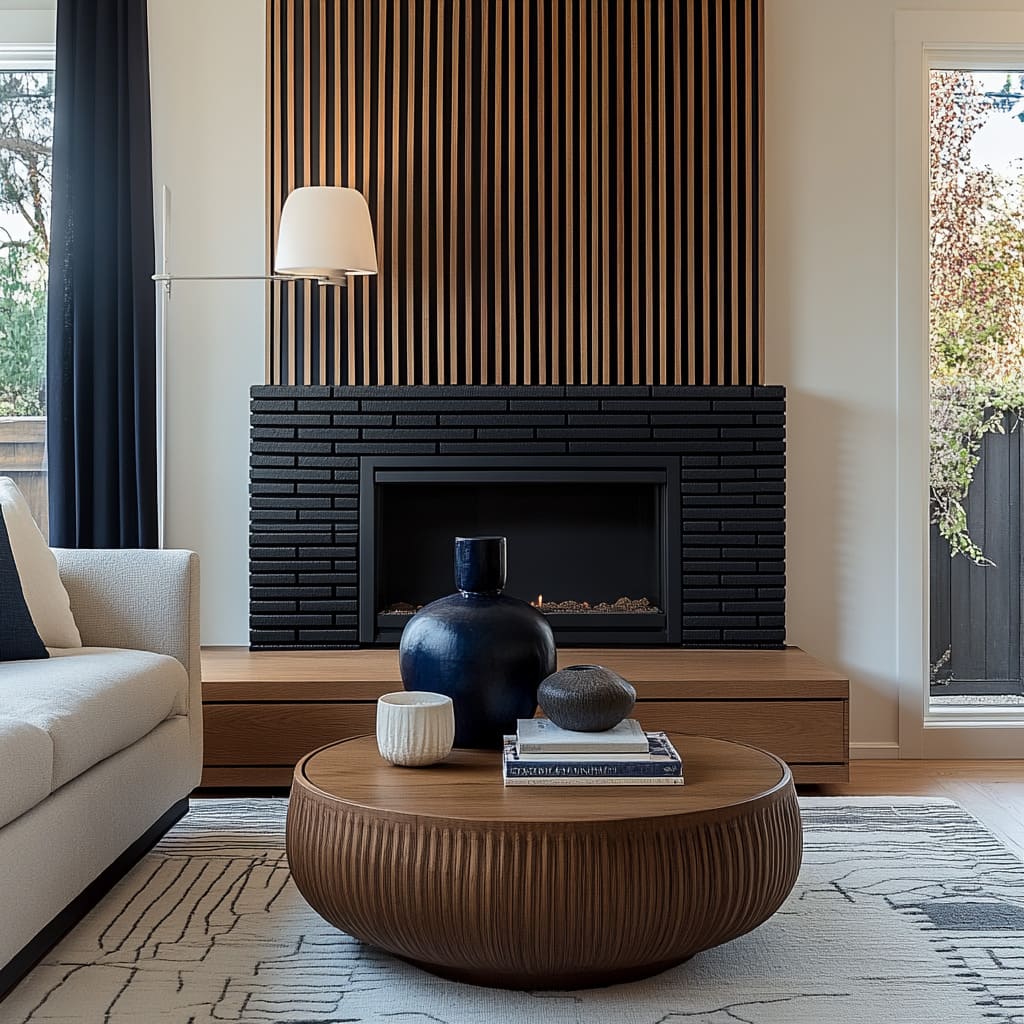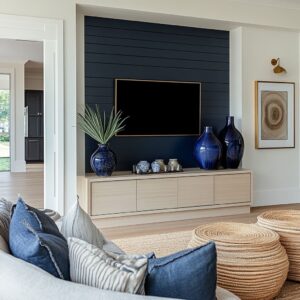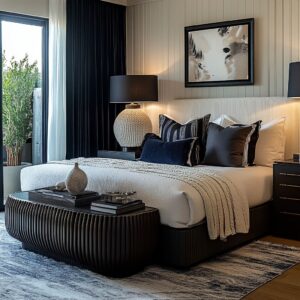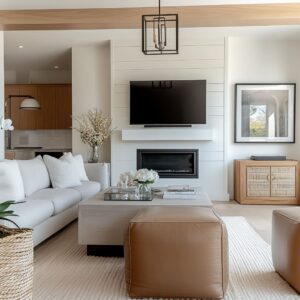A black fireplace can become one of the most striking elements in a living room, providing depth, contrast, and character. Whether you’re aiming for a modern centerpiece or a classic accent, black’s versatility allows it to blend with various interior styles.
The challenge is to plan the design so that it becomes a captivating focal point without overpowering the space. From choosing complementary materials to incorporating the right lighting, the design process demands careful thought.
The interplay of natural textures, layered illumination, and coordinated colors can turn a simple fireplace into a welcoming showpiece. Whether it’s contrasted with light walls or framed by textured elements, a black fireplace can be both functional and artful.
In this article, we’ll look at the fundamental principles, techniques, and design ideas that keep black fireplaces timeless. From pairing materials to smart decor choices, you’ll learn how to create a standout feature that enhances the comfort and style of your living room.
Guiding Principles for Designing Black Fireplaces
Balance Between Boldness and Subtlety
Designing a black fireplace that draws the eye without dominating the room is both an art and a science. These bold features provide dimension and a statement in any interior, but their strong presence calls for skillful planning.
Done well, a black fireplace can feel like an integral part of the room, bringing unity rather than intrusion. Because black creates intense contrast in lighter spaces, designers often use natural elements (like wood or stone) to soften its impact and foster a more inviting look.
For instance, surrounding a black fireplace with honey-toned wood or textured stone introduces warmth, ensuring the design doesn’t overshadow the room. Lighting also helps achieve the right balance.
Subtle LED strips or carefully placed fixtures can accentuate the fireplace’s surfaces, creating a gentle transition between dark tones and neighboring features. Striking the right balance helps the fireplace merge with its environment rather than steal the spotlight.
Integration with Surrounding Elements
A black fireplace appears more natural when the room itself is cohesive. Finishes such as textured walls, light-colored paint, or coordinating wood accents can bind the fireplace to its surroundings.
Built-in shelving or other matching architectural details (like vertical wood slats or brick walls) can frame it nicely, making the fireplace feel like an organic extension of the space. This applies to furniture and décor as well.
A neutral sofa or a minimalist coffee table complements the fireplace without making the room feel cramped. Every item should align with the same design vision, ensuring harmony throughout.
When well-coordinated, the fireplace feels like a purposeful addition to the interior.
Highlighting Through Contrast
Contrast remains an effective strategy for ensuring a black fireplace stands out without being too imposing. Designers frequently pair black fireplaces with light walls or floors for a sharp, eye-catching effect.
Pale flooring, such as oak or ivory rugs, can lift the space and keep the dark tones from feeling heavy. Natural light is also important.
Sun streaming in through large windows softens the darkness of the fireplace, producing a dynamic blend of light and shadow. Layered textures and light décor items—like linen drapes or cream seating—further underscore the dramatic aspect of black without letting it overshadow everything else.
Emphasis on Texture and Pattern
Flat black surfaces can come across as stark, but adding texture or pattern keeps them visually appealing. Brick, fluted panels, or patterned tile infuse depth and personality.
Veined black marble or herringbone tile also add intriguing details. These layers help maintain boldness while avoiding a monotonous look.
Pairing different textures is another way to introduce dimension. A matte black brick fireplace alongside polished wood, for example, highlights contrasting surfaces that feel compelling and well-rounded.
Designers often refer to these as versatile, layered fireplace wall concepts, where texture keeps the design both striking and harmonious.
Functional and Aesthetic Integration
A fireplace serves as a source of warmth, but it also anchors a living room visually. Practical components such as mantels or hearths can blend form and function.
A sleek black mantel might act as a display ledge for understated décor, while a stone hearth provides both utility and visual continuity. Shelving, cabinets, or integrated lighting surrounding the fireplace can also reinforce its role.
When planned to work alongside these elements, the fireplace goes beyond merely providing heat, becoming a unifying architectural feature that complements the room’s overall character. In short, designing a black fireplace is about reconciling boldness and nuance.
By balancing materials, lighting, and textures, you can ensure this feature elevates rather than overshadows the space. Through contrasts, cohesive elements, or texture-rich surfaces, these principles open up endless possibilities for beautiful black fireplaces that perform as both functional and aesthetic additions.
Design Principles and Schemas
Creating a black fireplace that brings both style and unity to a living room is a chance for innovation and precision. These fireplaces can transform interiors into breathtaking focal points, but they need a considered approach for true harmony.
Whether you lean on symmetry, contrast, or a strategic blend of materials, success depends on both timeless design principles and inventive patterns. Below, we explore actionable ideas for making sure a black fireplace aligns with and enhances its surroundings.
Contrast
Contrast is key for black fireplaces. Pairing matte black finishes with lighter elements (soft white walls, natural wood floors, or metallic accents) creates a balanced visual interplay.
For instance, a black fireplace flanked by white shiplap or accented with brass sconces naturally commands attention but still merges with the rest of the design.
—Contrast highlights black fireplaces, ensuring they stand out while meshing with gentler tones.
Symmetry and Asymmetry
Designers often opt for symmetry by placing shelving or wall sconces on both sides of a fireplace, which works well in traditional or transitional rooms. Asymmetry, however, can infuse a more contemporary vibe.
Off-center built-ins, varied accessories, or an eclectic art arrangement keep the layout dynamic.
—Symmetry offers a sense of order, while asymmetry introduces movement and a modern twist.
Proportion and Scale
The fireplace’s dimensions must suit the room. A tall fireplace emphasizes vertical space and draws the eye upward, perfect for rooms with lofty ceilings.
A wide, low-profile design grounds the area and accentuates horizontal flow. Aligning the fireplace size with the room’s scale ensures it neither feels intrusive nor underwhelming.
—Thoughtful scaling maximizes architectural features and prevents the fireplace from feeling out of place.
Layering
Layering materials (like brick, wood, or veined marble) adds complexity and richness to a black fireplace wall. Lighting is important here: recessed LEDs or pendant fixtures highlight textures, while carefully chosen décor (like art or greenery) ties everything together.
—Layering transforms a flat black fireplace into an engaging design element full of depth.
Design Schemas
Natural-Industrial Fusion
A black fireplace can pair beautifully with reclaimed wood or exposed brick, producing a blend of raw textures and modern touches. A few well-placed plants or soft textiles can mellow the industrial edge, resulting in a welcoming, balanced look.
—Combining natural materials with black surfaces creates a grounded yet chic ambiance.
Modern Luxury
Sleek black marble fireplaces with metallic accents define modern luxury. Details in gold or brushed nickel, along with glossy finishes, evoke refinement.
This approach suits contemporary interiors that value a high-end aesthetic.
—Sophisticated metals and polished surfaces bring an elevated sense of style to a black fireplace.
Organic Contemporary
Incorporating soft, nature-inspired textures—like woven fabrics and greenery—tones down the bold impact of black. A dark fireplace framed by pale wood paneling and casual textiles can foster a serene yet modern environment.
—Natural elements help balance a bold fireplace, making the space feel cozy and current.
Minimalist Focus
Here, simplicity prevails, letting the black fireplace speak for itself. Clean lines and minimal décor highlight the fireplace’s distinct shape and finish.
It’s an enduring strategy that works well in modern or Scandinavian-inspired spaces.
—A pared-down approach allows the black fireplace to command attention through straightforward yet striking design.
By harnessing contrast, symmetry, proportion, and layering—and then choosing the right schema—your black fireplace can become a truly engaging statement in the living room. Whether it’s merged with an industrial theme or given a more refined veneer, these guiding ideas ensure it remains both bold and cohesive.
Practical Guidelines and Strategies
Material Selection
Designing a fireplace involves striking the right balance between aesthetics, usefulness, and an understanding of materials. When you focus on dark fireplace ideas, coordinating strong, dramatic surfaces with complementary design moves is key to sustaining harmony in the room.
Whether your style skews rustic, modern, or transitional, choosing materials carefully, selecting fitting color schemes, planning the lighting, and framing the fireplace intentionally can deliver a stunning focal point. Below are practical ideas for living rooms with black fireplaces that are both eye-catching and cohesive.
The base material sets the overall tone. Brick offers a timeless feel with a textured surface that works well in rustic or transitional spaces, especially when contrasted with smoother elements elsewhere.
For added luxury, black marble with sweeping veining provides a refined, artistic flair, reflecting light to soften the depth of black. If you lean toward an industrial style, consider metal in matte or brushed finishes for an edgy yet refined look.
Add wood paneling to temper the boldness of black and lend warmth. The key is to pick materials that connect naturally with the broader room design.
—Materials set the stage for how the fireplace integrates, from rugged to sophisticated.
Color Combinations
Color coordination can help a black fireplace flow gracefully with the rest of the interior. Light neutrals (white, beige, pale gray) often accompany black fireplaces, amplifying contrast and brightening the room.
Touches of natural wood can infuse further warmth in flooring or furnishings. Alternatively, add bolder shades like navy or burgundy through accents like pillows, art, or rugs for added depth and character.
These hues highlight the black fireplace’s sense of drama without overwhelming the space.
—Well-placed neutrals and accents keep the fireplace striking yet harmonious.
Lighting Integration
Illumination plays a major role in accentuating the beauty and depth of a black fireplace. Recessed LED strips can outline architectural features, while a statement pendant above the fireplace can cast a warm glow.
Both draw attention to the fireplace while keeping the room comfortable. Ample sunlight from generous windows also tempers the darkness of black fireplaces, interacting with surface textures and creating a pleasing mix of light and shade.
—Lighting should highlight the fireplace’s best features while maintaining an inviting atmosphere.
Mantel Styling
The mantel provides a canvas for subtle décor. A minimalist approach helps prevent clutter, allowing the fireplace to remain the centerpiece.
Items like ceramic vases or small potted plants introduce a gentle, natural touch, while metallic candleholders contribute sophistication. Art is another mantel favorite—abstract or geometric pieces in complementary hues provide visual intrigue without stealing focus from the fireplace.
—Mantel décor adds personal flair and warmth but should stay restrained to maintain balance.
Placement and Framing
The position and framing of a fireplace often dictate how effectively it becomes a focal point. Vertical paneling extending above the fireplace can draw the eye upward, imparting a sense of grandeur.
Flanking windows bring sunlight and symmetry, while built-in shelves supply extra function and help the fireplace blend into the layout. Together, these elements ensure the fireplace feels naturally embedded in the space rather than an isolated feature.
—Strategic positioning and architectural details anchor the fireplace, delivering both visual and functional harmony.
By thoughtfully selecting materials, balancing the color scheme, incorporating layered lighting, dressing the mantel, and framing the fireplace with care, a dark fireplace idea can flourish.
Each strategy contributes to a unified look, ensuring the fireplace serves as a bold centerpiece without overwhelming its environment.
Creative Design Ideas
Using Textures as Visual Softeners
Black fireplaces can instantly draw attention, but it’s important to keep the design inviting. Through imaginative textures, extending the fireplace vertically, or pairing it with complementary décor, you can shape a room that is both visually engaging and comfortable.
Below are practical ways to decorate with a black fireplace while preserving the room’s easy, welcoming feel. Textures keep a black fireplace from feeling overly stark or weighty.
Brick, tile, or wooden slats offer tactile interest and relieve the uniformity of dark surfaces. A black brick fireplace, for instance, balances a rustic vibe with warmth, while shiny black tile provides a more contemporary look.
Contrast-colored grout lines can further highlight patterns. When chosen well, textured materials ensure the fireplace blends with the rest of the interior and remains an approachable focal point.
—Texture adds dimension, creating a layered effect rather than a flat, heavy presence.
Vertical Extensions to Maximize Height
In spaces with tall ceilings, running the fireplace surround upward with matching panels or cladding emphasizes the room’s lofty proportions. This draws the eye, lending a striking yet cohesive presence.
For example, wood or metal paneling rising above a black fireplace can make an architectural statement without feeling out of place.
—Vertical extensions amplify impact while remaining consistent with the room’s scale.
Dual-Tone or Layered Finishes
Blending black surfaces with contrasting finishes, such as oak or polished metal, adds variety and prevents monotony. Think of black marble with oak cabinetry or matte black tile with white grout.
Such pairings keep the fireplace design vivid and adaptable to multiple styles.
—Contrasting finishes generate visual intrigue and break up an otherwise uniform expanse of black.
Minimalist Fireboxes
Narrow, linear fireboxes have become a hallmark of modern black chimney ideas. They provide a clean silhouette, maintain an open feel, and appear both subtle and statement-making.
With bold black cladding surrounding a slim firebox, contemporary rooms gain a sleek focal point without clutter.
—Streamlined fireboxes support a modern aesthetic and let the main fireplace design shine.
Organic Decor Pairing
Fusing a black fireplace with organic accents, like greenery, natural textiles, or earthy ceramics, softens its strong lines. This approach weaves warmth and texture into the setting, balancing the bold color and tying it neatly to the rest of the décor.
—Combining bold tones with nature-inspired details creates comfort and visual balance.
Whether through textures, layered finishes, or organic elements, these ideas ensure black fireplaces remain eye-catching yet cohesive.
By following these strategies, you can create a living room feature that feels both bold and welcoming.
Design Elements That Enhance Harmony
Flooring Choices
A black fireplace can bring a touch of refinement and comfort to any living room. Yet to ensure harmony, every design choice—from flooring and furniture arrangement to textiles and décor—matters.
Below are the main considerations for tying a black fireplace seamlessly into a warm, inviting setting. Flooring sets the foundation for the black fireplace’s effect on the room.
Light wood or stone floors create a pleasing contrast, softening the dark fireplace and reflecting more light. For instance, pale oak can brighten the space, while neutral stone in beige or gray adds both texture and sturdiness.
Through such balance, the black fireplace remains a highlight, yet the overall design stays open and airy. Meanwhile, organic hues in wood or stone help the fireplace coordinate with the rest of the interior.
—Flooring provides warmth and contrast, reducing any sense of heaviness from the black fireplace.
Furniture Placement and Color
Positioning and color choices for furniture can subtly underscore the fireplace without letting it dominate. Neutral or earthy-toned sofas and chairs (think beige or tan) serve as a calm backdrop.
Often, designers place seating in a U-shape or semicircle, with the fireplace as the focal point. Textured fabrics—linen or velvet—offer visual interest and comfort, offsetting the harder surfaces of the fireplace.
Understated hues help the dark fireplace shine without causing the room to feel overly intense.
—Calm, neutral furniture positioning and tones draw attention to the fireplace while keeping the room approachable.
Rugs and Textiles
Rugs help ground seating areas and contrast with the sleek or textured surface of a black fireplace. Plush rugs, for example, provide cozy appeal, while geometric or abstract patterns can pick up tones found elsewhere in the décor.
Coordinating pillows or throws in soft grays, muted blues, or other subtle colors can gently unite the fireplace with the rest of the living room. These textile choices add softness, preventing the fireplace from dominating the environment visually.
—Thoughtful rugs and fabrics unite the space, creating a layered, cohesive look around the black fireplace.
Decor and Artwork
Decor and artwork around the fireplace help refine its strong outline and personalize the space. Circular mirrors, for example, contrast with the sharp lines of the fireplace, promoting visual balance.
A well-chosen painting or print in soft or complementary colors can also draw the eye without competing. Mantel decor might include small greenery, candles, or decorative bowls—kept minimal so as not to take the spotlight away from the fireplace.
When done well, these finishing touches add flair and warmth while preserving the fireplace’s star status.
—Subtle decor softens the fireplace’s bold look and adds a personal touch that ties into the broader room design.
By thoughtfully choosing flooring, furniture, textiles, and accessories, you can ensure your black fireplace fits naturally into the space. Each element plays a part in balancing strong color contrasts, allowing the fireplace to become an inviting focal point.
Practical Combinations
Material Balancing
Achieving a harmonious black fireplace often means coordinating materials, proportions, lighting, and color. With the right balance, a black fireplace becomes a powerful statement that still feels at home in the room.
Below are practical ways to blend boldness with overall design continuity. Striking the right mix of dark finishes and lighter, natural elements helps avoid visual heaviness.
Matte black surfaces with oak or walnut soften the contrast. Meanwhile, polished black marble with brushed gold accents creates a more luxurious effect, exuding sophistication while remaining tasteful.
These pairings introduce depth and make the fireplace adaptable to different aesthetics, whether rustic or modern.
—Pair black with lighter materials or metallic accents to achieve visual and stylistic harmony.
Proportional Scaling
A black fireplace should fit the room’s dimensions to avoid looking cramped or outsized. In cozy rooms, smaller fireplaces with built-in shelving maintain functionality and look proportionate.
Larger spaces can handle broader designs without overwhelming the layout. Height and width also matter.
A taller fireplace can highlight vertical space, while a wider model emphasizes horizontal flow.
—Keeping the fireplace in proportion to the room ensures it feels organic and visually comfortable.
Layered Lighting
Lighting elevates a black fireplace’s visual appeal. Ample daylight softens its depth, while ambient or accent lighting adds dimension after sunset.
Recessed LEDs or wall sconces can emphasize texture, drawing focus where you want it and fostering a welcoming mood. This layered approach makes the fireplace the focal point without leaving the room dark or unbalanced.
—Combine various lighting sources to showcase the fireplace’s beauty and maintain a warm environment.
Color Palette Coordination
Colors throughout the room often complement the black fireplace for a unified look. Neutral walls (white, beige, gray) offer a fresh backdrop that highlights the fireplace’s bold presence.
Subtle accent hues—navy or mustard, for example—introduced in decor or textiles add interest without overshadowing the feature. This coordinated palette weaves the fireplace smoothly into the entire room’s design.
—Aligning your color choices with the fireplace ensures a cohesive and balanced look.
By focusing on material combinations, appropriate scale, layered lighting, and complementary color schemes, you can design a black fireplace that serves as both a focal point and a harmonious part of the living room.
These principles ensure your black fireplace stands out while still blending with the space around it.
Conclusion: Key Takeaways for Designing a Black Fireplace
Black fireplaces are most successful when woven into a balanced plan. Textures, lighting, and natural accents help soften their depth, while proportion, contrast, and layered finishes keep them visually appealing but never overbearing.
Creative combinations of materials and carefully chosen decor complete the look. By following these techniques, homeowners and designers can create black fireplaces that are both functional and artistic—bold enough to catch the eye, yet aligned with the overall design.

